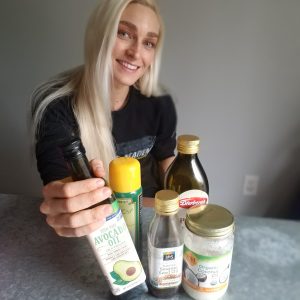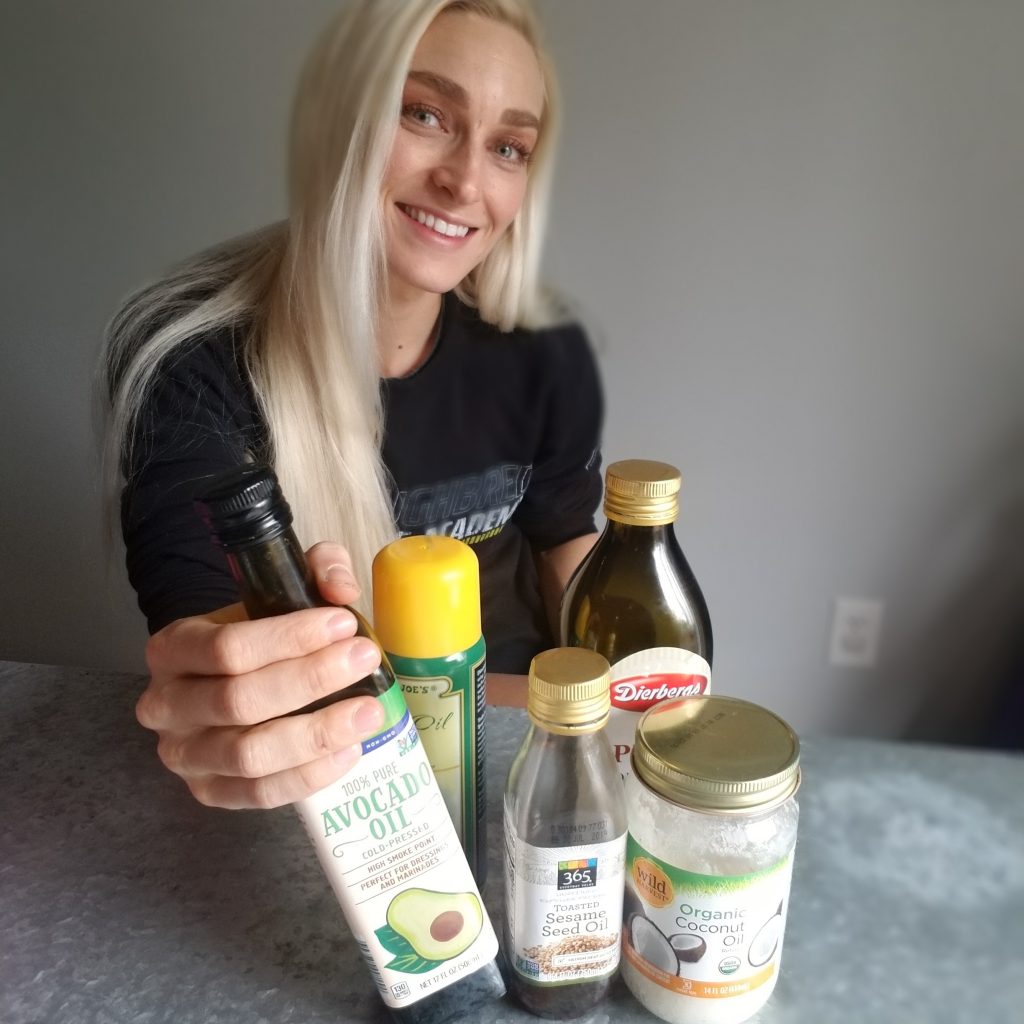NUTRITION
Just the Fats: Quick Breakdown of Dietary Fats

It’s one of the three main macronutrients in our diet and it’s essential to our health. I’m talking all about fat today. At nine calories per gram, fat supplies the body with a substantial energy, helps form cell membranes, and aids in the absorption of fat-soluble vitamins and minerals. Americans went through a phase (over 50 years) where we thought switching to a low-fat diet would improve our health but eventually, we learned that not all fat is created equal. I think low-fat diets are still something that many people follow, and medical professional recommend to improve health, but we have also seen obesity and diabetes rates continue to increase. So, what gives? Why after all this time are we still getting it wrong? My opinion on improving your health is not by just listening to what the media tells you is right, but to educate yourself to make the best choices for you and your body. And with current nutrition information, it’s very clear that some types of fat can improve your health so it’s time you get to know your fats.
The three main types of fats are saturated, unsaturated and trans fats. Unsaturated fats are typically liquid at room temperature and are beneficial to our overall health. They can improve cholesterol levels, heart health and reduce inflammation. Unsaturated fats are largely found in foods from plants and can be further divided into monounsaturated fats and polyunsaturated fats. Most foods have a mixture of fats saturated and unsaturated fats so the examples below are good sources of the following.
Monounsaturated fats are found in:
- Olive oil, peanut oil, canola oil
- Avocados
- Almonds, pistachios, cashews, hazelnuts
- Pumpkin seeds and sesame seeds
Omega- 9 fatty acids are a type of monounsaturated fat, also an oleic acid, that can often be found in canola, sunflower, olive, and nut oils. These oils have a significant level of omega-9 fatty acid, which now replace lots of partially hydrogenated cooking oils. Omega-9 fatty acids have been shown to increase HDL and decease LDL and can help reduce plaque build-up in the arteries. More on canola oil another day.
Polyunsaturated fats are found in:
- Corn, cottonseed, sunflower and safflower oils
- Flax and flaxseed oil
- Soybeans and soybean oil
- Walnuts, pecans and pine nuts
- Cold water fish
- Tub margarine
A subcategory of polyunsaturated fats are omega-3 and omega-6 fatty acids, which are essential and required for normal body function, therefore they must be obtained from foods. Omega- 3 fatty acids health help lower risk for chronic diseases like heart disease and help lower LDL cholesterol. Alpha-linolenic acid (ALA), eiocosapentaenoic acid (EPA), and docosahexaenoic acid (DHA) are the 3 types of omega-3 fatty acids. ALA can enhance the elasticity of blood vessels while EPA/DHA help with brain and eye development and research suggests it can help prevent cardiovascular disease.
ALA:
- Canola Oil
- Soybean Oil
- Walnuts
- Flaxseed
EPA:
- Oily fish like cod liver, herring, salmon, sardines, and mackerel
DHA:
- Same sources as EPA, and produced from algal fermentation
Omega- 6 fatty acids include linolenic acid (LA) and arachidonic acid (AA). Excessive amounts of LA can cause inflammation and result in heart disease, cancer, arthritis and more. The key is striking a balance between omega-3’s and omega-6s in the diet to reduce inflammation and promote health.
LA:
- Soybean oil, corn oil , safflower oil, sunflower oil , peanut oil, cottonseed oil and rice bran oil
AA:
- Peanut oil, meat, eggs and dairy products
Are you still with me? Now we get to the not so good fats. Let’s start with saturated fats. Saturated fats are typically solid at room temperature and if consumed in excess, can increase your risk for high blood pressure, atherosclerosis, heart attack and stroke. They have been shown to raise LDL and lower HDL cholesterol.
Saturated fats are found in:
- Fatty meats
- Full fat dairy
- Butter
- Hard margarine
- Lard
- Coconut oil
- Ghee
- Palm oil
For years we have been advised that saturated fat is harmful to our health and increases our risk of heart disease. Several studies suggest that this is not necessarily true and there isn’t enough evidence to suggest that saturated fat alone was to blame (1). What can be concluded is that replacing saturated fats with fats like polyunsaturated can improve cholesterol and lower your risk of heart disease (2). Saturated fat might not be a harmful as we once thought, however research clearly shows that unsaturated fats are the most beneficial type of fat. Medium chain triglycerides are a type of saturated fat primarily found in coconut oil, palm kernel oil, and full fat dairy. Some research shows they benefit fat loss to a minor extent when consumed in place of other dietary fats (3).
We have finally made our way to trans fats. These are made by heating vegetable oils in the presence of hydrogen gas and a catalyst; this is hydrogenation. Partially hydrogenated oils are more shelf stable and can withstand high heat because of this process. They are often found in baked goods, processed snack foods, and fried foods. There are some naturally occurring trans fats in the diet found in beef fat and dairy fat in small amounts. Trans fats are the most harmful type of fat in the diet and can raise LDL cholesterol, lower HDL cholesterol, create inflammation and increase insulin resistance. Even a small amount (as little as 2% of daily calories from trans fats) can increase the risk for coronary heart disease by 23% (4). In 2003, The FDA ruled that trans fats must be declared on the Nutrition facts label and the food industry went through a major makeover. The nutrition community had already been informing the public that “partially hydrogenated oils” and “vegetable oils” in the ingredients list was really code for trans fat and consumers were on the lookout, avoiding products that contained these ingredients. While this was a huge win in many ways there are still loopholes to the ruling. Manufacturers can still claim “0 g trans fat” per serving if the item contains less than 0.5 grams of fat per serving. This might sound minuscule but, how many people eat the suggested serving size? I imagine it’s easy to consume multiple products in a single day that contain trace amounts of trans fat and that can add up. What about foods without labels from bakeries or restaurants. In 2015, the FDA rules that partially hydrogenated oils are no longer “generally recognized as safe”. The majority of trans fats will be phased out the American food supply by 2021. Trans fast are still used in other countries and the World Health Organization has created campaign called “REPLACE” that calls on governments to eliminate all trans fats by 2023 (5).
Now that you have all of this information, start small by implements some changes in your diet when it comes to fats. Here are some easy things you can start doing right away!
- Incorporate a variety of nuts, seeds, and oils into your diet
- Eat fish like salmon, mackerel, tuna, or sardines twice a week
- Check the ingredients list for “partially hydrogenated” on processed foods. If you do eat these products, try to make sure “partially hydrogenated” is towards the bottom of the ingredients list.
- Snack on healthy fats
- Use oils when cooking
- Choose lean cuts of meat
Don’t get caught up in too much information. Many foods contain a mixture of both saturated and unsaturated fats, so focus on consuming more of the unsaturated sources. Fat is nutrient and calorie dense and needed for our overall health and function of our body. Removing too much fat from your diet and choosing foods that are marketed as “low-fat” or “fat-free” may lead to more harm than good. Know your fats and enjoy them as part of a balanced, sustainable diet.
Sources:
- Siri-Tarino, P.W., et al., (2010). Meta-analysis of prospective cohort studies evaluating the association of saturated fat with cardiovascular disease. Am J Clin Nutr, 91(3): p. 535-46.
- Farvid MS, Ding M, Pan A, Sun Q, Chiuve SE, Steffen LM, Willett WC, Hu FB. (2014). Dietary Linoleic Acid and Risk of Coronary Heart Disease: A Systematic Review and Meta-Analysis of Prospective Cohort Studies.
- White MD, Papamandjaris AA, Jones PJ., (1999). Enhanced postprandial energy expenditure with medium-chain fatty acid feeding is attenuated after 14 d in premenopausal women. AM J Clin Nutr. 69(5): p. 883-9.
- Harvard School of Public Health. (2020). The Nutrition Source: Types of fat. https://www.hsph.harvard.edu/nutritionsource/what-should-you-eat/fats-and-cholesterol/types-of-fat/#ref1
- World Health Organization. (2020). REPLACE Trans Fat-Free by 2023. https://www.who.int/nutrition/topics/replace-transfat

